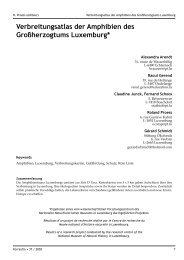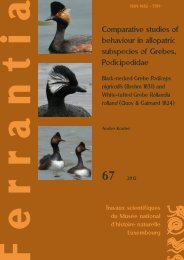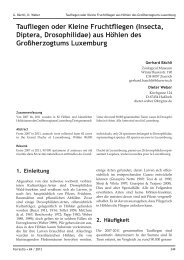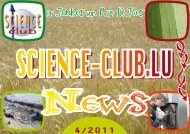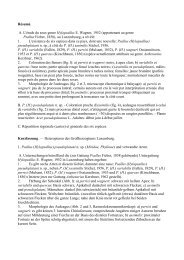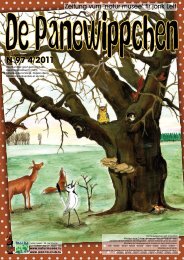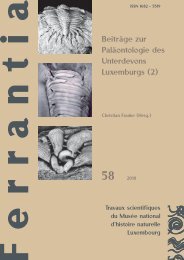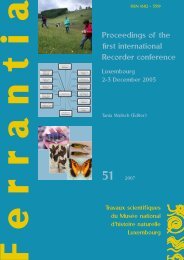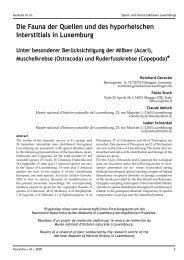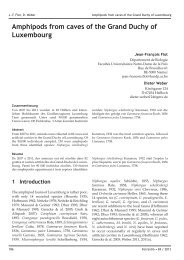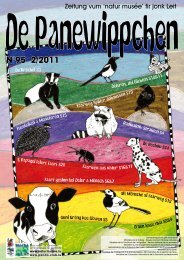Publi.complète - Musée national d'histoire naturelle
Publi.complète - Musée national d'histoire naturelle
Publi.complète - Musée national d'histoire naturelle
You also want an ePaper? Increase the reach of your titles
YUMPU automatically turns print PDFs into web optimized ePapers that Google loves.
Delsate, Steur, Schneider, Thuy Lower to Middle Emsian flora and fauna from Consthum and Merkholtz<br />
porites annulatus, E. rotatus, Streelispora newportensis,<br />
Verrucosisporites polygonalis, an assemblage<br />
aributed to the Middle Emsian rather than to the<br />
Lower Emsian .<br />
2.3. New palynological data<br />
P. Steemans (ULg) performed new tests on 3<br />
samples from the 2 localities: Consthum level<br />
with Porolepis scales (eastern part of the quarry),<br />
Consthum level with specimen EIB153, about 100<br />
m NW of the Porolepis scales point, and Merkholtz<br />
level with Drepanaspis. The spores in the 3 samples<br />
are rather similar, with the stratigraphically<br />
important: Acinosporites lindlarensis Riegel 1968,<br />
Apiculiretusispora brandtii Streel 1964, Dibolisporites<br />
echinaceus (Eisenack) Richardson 1965 emend. Mc-<br />
Gregor 1973, Dibolisporites weeldorfensis Lanninger<br />
1968, Emphanisporites zavallatus Richardson et<br />
al. 1982 var. nodosus Steemans 1989, Rhabdosporites<br />
minutus Tiwari & Schaarschmidt 1975.<br />
Such a miospores assembly is typical of the<br />
Emsian. The presence of R. minutus and A.<br />
lindlarensis leads to estimate that the 3 samples<br />
belong at least to the interval biozone “Min” of the<br />
Ferrantia • 36 / 2003<br />
“FD” assembly biozone (Fig. 2). In the absence of<br />
more recent taxa, the levels could be aributed to<br />
this “Min” biozone. However, the palynomorphs<br />
are poorly preserved, and their biodiversity is<br />
low (most of the species are simple forms of<br />
poor stratigraphical indicators like Retusotriletes,<br />
Apiculiretusispora). This prevents to completely<br />
exclude a somewhat younger age (Biozone “AP”)<br />
of the samples, which however would not reach<br />
the top of the Emsian, when very particular forms<br />
appear, like Hystricosporites and Ancyrospora, not<br />
observed here. In the Porolepis Consthum sample,<br />
a very badly preserved spore might be aributed<br />
to Acinosporites apiculatus (Streel) Streel 1967,<br />
aributing its level to the overlying “AP” biozone,<br />
of which this species characterizes the base.<br />
These new observations confirm the Steemans et<br />
al. 2000 conclusions, on a sample taken some 10<br />
m west of the Drepanaspis level of Merkholtz. The<br />
age is approximatively aributed to the Middle to<br />
Upper parts of the Emsian, without reaching its<br />
top. However, it must be noticed that the spores<br />
biozones have not been calibrated as Lower, Middle<br />
or Upper Emsian. Moreover, palynologists<br />
formerly considered the appearance of Emphanisporites<br />
annulatus, as the base of the Emsian, in the<br />
Biozones Âges<br />
Vel Eifélien<br />
AP Pro<br />
Cor sup?<br />
Min<br />
FD Pra moy?<br />
Fov Emsien<br />
AB<br />
inf?<br />
Su<br />
PoW Pa<br />
Po Praguien<br />
W<br />
Fig. 2 : Biozones from the Pragian to the Eifelian, after Streel et al. 1987 and 2000<br />
11



